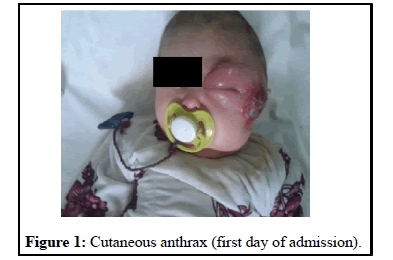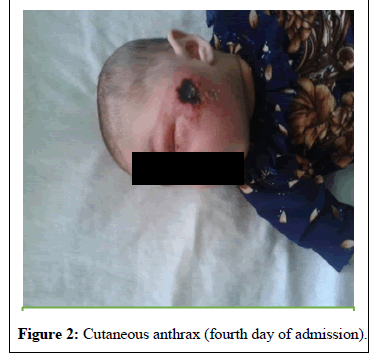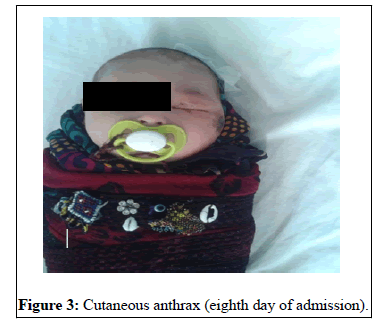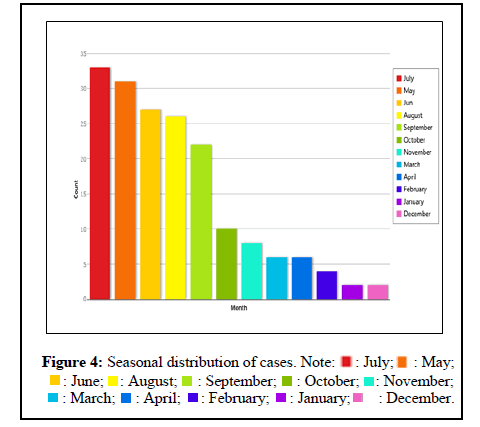Case Series Study of Human Cutaneous Anthrax in Dermatology Department, Herat Regional Hospital, Herat City-Afghanistan Feb 2014 to October 2017
Received: 14-Dec-2021 / Manuscript No. JIDT-21-49771 / Editor assigned: 16-Dec-2021 / PreQC No. JIDT-21-49771(PQ) / Reviewed: 28-Dec-2021 / QC No. JIDT-21-49771 / Revised: 31-Dec-2021 / Manuscript No. JIDT-21-49771(R) / Published Date: 07-Jan-2022 DOI: 10.4172/2332-0877.1000489
Abstract
Objective: The aim of this study is to evaluate the extent and burden of cutaneous anthrax in western part of Afghanistan.
Materials and methods: Total of 177 Admitted Cutaneous Anthrax (101 Female and 76 Male) were recruited in a retrospective study. The patients suspected having either visceral or inhaled anthrax in primary clinical impression and patients with mild diseases who were treated as out-patients, were excluded from the study. The data was generated from the registration book and patients’ files. EPI Info 7 software was used for analysis of data.
Results: The age of participants was between 6 months to 74 years with a mean of 20 years. The hospital average length of stay was 4.5. Face (mostly Eyelids) was the most common involved site (82% for over 5 Years old) however; it was 98% for fewer than 5. The hands (11%), neck (4%), trunks (2%) and other parts (1%) were affected respectively. 71% of the study population were residents of Herat districts, 19% from neighboring provinces, and only 10% from Herat city. 4 patients escaped without medical permission and considered as default. 2 deaths (1 Male and 1 Female) occurred for over 5 patients, all the other patients were discharged with good health, however, the squeal (crust, and mild edema) was still present in most cases during the discharge time. Ciprofloxacin was the drug of choice regardless the sex and age, Dexamethasone was used as an adjuvant therapy.
Conclusion: Although cutaneous anthrax is less prevalent now in other countries, it still highly affects Afghanistan population. Female higher prevalence rate necessitates comprehensive plan for community awareness focusing on the female group, collaboration and coordination among different stakeholders is mandatory to address this simple still fatal challenge.
Keywords
Anthrax; Visceral; Prevalence; Ciprofloxacine; Death
Introduction
Anthrax is zoonotic diseases caused by Bacillus anthraces, an aerobic, gram positive bacillus. Depending on route of exposure, cutaneous, gastrointestinal and inhalational forms of the diseases occur in people [1]. Sepsis or haemorrhagic meningitis may develop from any kind of anthrax infections. Most cases are cutaneous and the case fatality is <1% if treated properly. In developed countries, it is declining but in developing countries it is still a great public health burden, especially in low income group people.
Case Study
Sporadic cases are served every day in our hospital and other clinics, increasing the number of cases during the study time, gave as the idea to collect, aggregate, analyse and interpret the data in order to find out the burden of the diseases and to advocate for developing strategies to overcome the issue.
Objectives
To evaluate the disease burden as public health challenge.
To assess the socio – demographic distribution of human cutaneous anthrax.
Total of 177 Admitted Cutaneous Anthraces (101 Female and 76 Male) were recruited in a retrospective study in dermatology department. The patients suspected having either visceral or inhaled anthrax in primary clinical impression and patients with mild diseases who were treated as out-patients, were excluded from the study. Cases either admitted or treated as OPD in infectious ward of the hospital were also not included in the study. All the cases were diagnosed clinically; skin lesion developed over 2-6 day from a papule through a vesicle, to a depressed black eschar with mild to severe non-pitting edema. No laboratory confirmation was done. Differential diagnoses were made wherever appropriate. 1 resident was assigned to collect the data from registration books and patients’ files. Variables such as; address of the patients, age, sex, site of involvement, duration of stay, time of admission, etc, were considered for data analyses. EPI Info 7 software was used for analysis of data.
Results
171 patients including 101 Female and 76 Male were enrolled in the study. The age of participants was between 6 months to 74 years with a mean of 20 years (Figures 1-3).
The hospital average length of stay was 4.5. Near all patients were almost illiterate with few have the ability of only basic reading and writing skills. Face (mostly Eyelids) was the most common involved site (82% for Over 5 Years old) however; it was 98% for <5. The hands (11%), neck (4%), trunks (2%) and other parts (1%) were affected respectively, Ulcer and edema seen in all cases; however, eschar seen in 163 patients (92%). 71% of the study populations were residents of Herat districts, 19 % from neighbouring provinces, and only 10% from Herat city. 4 patients escaped without medical permission and considered as default. 2 deaths (1 Male and 1 Female) occurred for over 5 patients, all other patients were discharged with good health, however, the squeal (crust, and mild edema) was still present in most cases on the discharge time. Ciprofloxacin was the drug of choice regardless of the sex and age; Dexamethasone was used as an adjuvant therapy. Although cases admitted throughout the year, there was a significant increase between May-September (Tables 1 and 2) (Figure 4).
| Age | Frequency | Percent % | Cum. % | 95% CI Lower | 95% CI Upper |
|---|---|---|---|---|---|
| 0-<10 | 65 | 36.72% | 36.72% | 29.62% | 44.28% |
| 10-<20 | 41 | 23.16% | 59.89% | 17.16% | 30.08% |
| 20-<30 | 19 | 10.73% | 70.62% | 6.59% | 16.25% |
| 30-<40 | 22 | 12.43% | 83.05% | 7.96% | 18.21% |
| 40-<50 | 7 | 3.95% | 87.01% | 1.60% | 7.98% |
| 50-<60 | 16 | 9.04% | 96.05% | 5.26% | 14.26% |
| 60-<70 | 4 | 2.26% | 98.31% | 0.62% | 5.68% |
| 70-<80 | 3 | 1.69% | 100.00% | 0.35% | 4.87% |
| TOTAL | 177 | 100% | 100% | - | - |
| Sex | |||||
| F | 101 | 57.06% | 57.06% | 49.42% | 64.46% |
| M | 76 | 42.94% | 100% | 35.54% | 50.58% |
| TOTAL | 177 | 100% | 100% | - | - |
| Year | |||||
| 2014 | 2 | 1.13% | 1.13% | 0.14% | 4.02% |
| 2015 | 91 | 51.41% | 52.54% | 43.80% | 58.98% |
| 2016 | 39 | 22.03% | 74.58% | 16.16% | 28.87% |
| 2017 | 45 | 25.42% | 100.00% | 19.19% | 32.50% |
| TOTAL | 177 | 100% | 100% | - | - |
| Address | |||||
| Herat city | 17 | 9.60% | 9.60% | 5.70% | 14.93% |
| Herat districts | 126 | 71.19% | 80.79% | 63.91% | 77.73% |
| Other provinces | 16 | 9.04% | 89.83% | 5.26% | 14.26% |
| Other provinces | 18 | 10.17% | 100.00% | 6.14% | 15.60% |
| TOTAL | 177 | 100.00% | 100.00% | - | - |
Table 1: Variables and study result.
| Site involved | Number (%) |
|---|---|
| Face | 145 (82%) |
| Hands | 19 (11%) |
| Neck | 7 (4%) |
| Trank | 4(2%) |
| Other parts | 2 (1%) |
| Total | 177 (100%) |
| Major Clinical Feature | |
| Ulcer | 177 (100%) |
| Edema | 177 (100%) |
| Eschar | 163 (92%) |
Table 2: Site involved and associated symptoms.
Discussion
Though anthrax is being eliminated or eradicated in most of the developed countries, it is still highly common in developing countries including Afghanistan. Weak surveillance system in veterinary does not provide sufficient information of the disease burden on the animals. This study revealed higher prevalence among the children less than 10 years (36%) regardless of the sex, however, in general the slight difference was seen between women (57%) comparing with men (43%). Almost half of the cases are admitted in infectious ward of the hospital or treated as OPD in the districts health facilities or other nonspecialized curative centers, and there is no formal surveillance system for this particular problem), hence, the real burden of the diseases remains unknown. Face was the most common involved site, which was different from the study of Mir Mobarak Hosin et al. in Bangladesh that had found the hands as the most common involved site [2]. This difference could be higher rate among children in our study while in Bangladesh study; the cases were more related to occupations and occurred in adults since our province is endemic for Congo Crimean Hemorrhagic Fever (CCHF), there is lot of efforts on community awareness on prevention of CCHF and this may consequently prevent spreading of anthrax from animal to the butcher while slaughtering a sick animal. In our study most of the patients had only a single lesion which supports the study of Mir Mobarak et al. in Bangladesh [2].
During 4 years (2014-2017) only in dermatology department of our hospital, 177 IPD cases of human cutaneous anthraces were admitted that were in severe form of the diseases, mild and OPD cases were not included in the study, while in 13 year study in Eastern Turkey, where is considered an endemic area, total of 403 cases were detected, this comparison indicates higher incidence and burden of the diseases in our country than of that in other endemic areas of the world. In the mentioned study, the seasonal increasing observed between April- September, our study shows similar case distribution with slight differences (July-September) [3-6]. Considering the climate and weather of two countries, both studies indicate the higher occurrence of the diseases during the time that the animal grazes in pasture and there are sufficient food supplies available for cattle. Because of weak animal health surveillance system, the main exposure to a sick animal or their products remains unknown.
Our study has limitation of generalization for several reasons;
Weak surveillance system in both animal and human anthraces.
Admission and caring of the cases in some private and public health facilities without data aggregation.
Inaccessibility to lab confirmation facility to confirm or rule out the clinically diagnosed cases.
As a retrospective study and weak patient’s files records, data collection would be less reliable.
Conclusion
Animal are the main reservoir and host for bacillus anthraces, but spore can be spread indirectly from dust, wools and other animal products. Paediatric higher incidence suggests that the cases can be transmitted more indirectly from mud, soil, etc. other than direct contact. Female are in higher risk of getting diseases due to direct and indirect contact with sick animals or their products. Low community awareness and lack of knowledge about also less control on industrial factories, is to be considered as co-facture for higher incidence of the diseases among the women. A collaborative team work among public health professionals, animal health care takers, and environmental health professional is recommended to develop a comprehensive policy controlling the diseases in animals ultimately controls the disease in human, therefore, strong surveillance system and public awareness and education of industrial owners, is mandatory to overcome this simple but fatal public health challenges.
Acknowledgment
We extend our keen appreciation and thanks to our dermatology department team, medical and hospital director, who provided supports and made it possible to accomplish this study.
References
- Wolff K, Goldsmith L, Katz S, Gilchrest B, Paller AS et al. (2008) Fitzpatrick's Dermatology in General Medicine.
- Mobarak MH, Rahman M, Shamim MRK (2013) Human Cutaneous Anthrax in Bangladesh. South Asia Regional One Health Symposium.
- Zulal O, Mehmet P, Rustu T, Ufuk D, Saglam YS, et al. (2005) Anthrax in Eastern Turkey, 1992-2004. Emerg Infect Dis 11:1939-1941.
[Cross Ref] [Google Scholar] [PubMed]
- Turnbull PCB, Hugh-Jones ME, Cosivi O (1999) World Health Organization activities on anthrax surveillance and control. J Appl Microbiol 87:318-320.
[Cross Ref] [Google scholar] [PubMed]
- Otlu S, Sahin M, Genc O (2002) Occurrence of anthrax in Kars district, Turkey. Acta Vet Hung 50:17-20.
[Cross Res] [Google scholar] [PubMed]
- Demirdag K, Ozden M, Saral Y, Kalkan A, Kilic SS, et al. (2003) Cutaneous anthrax in adults: A review of 25 cases in the eastern Anatolian region of Turkey. Infection 31:327-330.
[Cross Ref] [Google scholar] [PubMed]
Citation: Barakzie BA, Bagrami SA, Kakar M (2022) Case Series Study of Human Cutaneous Anthrax in Dermatology Department, Herat Regional Hospital, Herat City-Afghanistan Feb 2014 to October 2017. J Infect Dis Ther 10:489. DOI: 10.4172/2332-0877.1000489
Copyright: © 2022 Barakzie BA, et al. This is an open-access article distributed under the terms of the Creative Commons Attribution License, which permits unrestricted use, distribution, and reproduction in any medium, provided the original author and source are credited.
Select your language of interest to view the total content in your interested language
Share This Article
Recommended Journals
Open Access Journals
Article Tools
Article Usage
- Total views: 2997
- [From(publication date): 0-2022 - Nov 30, 2025]
- Breakdown by view type
- HTML page views: 2386
- PDF downloads: 611





 : July;
: July; : May;
: May; : June; :
: June; : : August;
: August; : September;
: September; : October
: October :November;
:November; : March;
: March; : April;
: April;  : February;
: February; : January;
: January; : December.
: December.